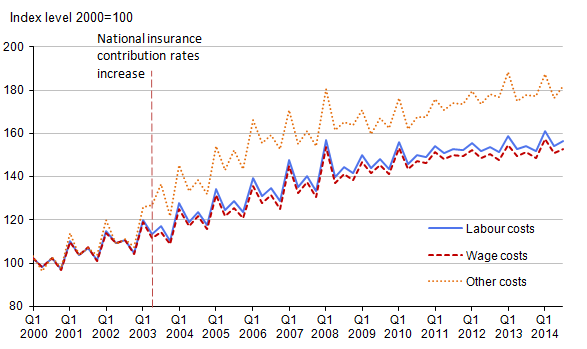1. Main points
The whole economy Index of Labour Costs per Hour (ILCH) increased by 1.3% in the third quarter of 2014 compared with the same quarter of 2013. This means the cost of labour rose year on year in Q3 2014, before inflation is taken into account
Wage costs per hour worked increased by 1.1%, and non-wage costs per hour worked increased by 2.5% in Q3 2014
The growth in labour costs per hour in the public sector was 2.0% in the third quarter of 2014, compared with 1.1% in the private sector
2. User engagement
We are constantly aiming to improve this release and its associated commentary. We would welcome any feedback you might have and would be particularly interested in knowing how you make use of these data to inform our work.
Please contact us via email: ster@ons.gov.uk or telephone Catherine Healey on +44 (0)1633 456786.
Back to table of contents3. Summary
The Index of Labour Costs per Hour (ILCH) is a measure of the cost of having an employee for an hour of work. It represents the total cost of employing an individual, which is primarily the earnings of the employee, but also includes non-wage costs. It is also known as the Labour Cost Index (LCI); the index is produced by all member countries of the EU and collated by Eurostat.
Four versions of ILCH are calculated for each aggregate, measuring changes in:
total labour costs per hour worked
wage costs per hour worked
other labour costs, primarily National Insurance contributions and occupational pensions, as well as sickness, maternity and paternity pay, per hour worked
total labour costs, excluding bonuses and arrears, per hour worked
The labour cost component of ILCH is mainly drawn from the Monthly Wages and Salaries Survey (MWSS); the hours worked component of ILCH is drawn from the Labour Force Survey (LFS). Other costs are estimated using a range of other sources including the Annual Business Survey (ABS) and Annual Survey of Hours and Earnings (ASHE). ILCH index figures are estimates in current prices, meaning that they are published not adjusted for inflation. ILCH data are not currently seasonally adjusted.
ILCH statistics are currently designated as experimental. Experimental statistics are those official statistics undergoing further development work before they are submitted for assessment as a National Statistic by the UK Statistics Authority.
Back to table of contents4. Main results
Whole economy labour costs per hour increased by 1.3% in Q3 2014 compared with the same quarter a year earlier. Total labour costs include wages and salaries, benefits in kind and employer social contributions (pension and national insurance contributions, sickness, maternity and paternity pay).
The growth in wage costs per hour worked was 1.1% and non-wage costs per hour worked increased by 2.5%. Wage costs include benefits in kind, wages and salaries. Non-wage costs include sickness, maternity and paternity pay, national insurance contributions and pension contributions.
Figure 1 shows the annual change in Labour Costs (per hour) for the whole economy, private and public sector.
Figure 1: Labour Costs per Hour year on year growth – whole economy, private sector and public sector, Q1 2009 – Q3 2014
UK
Source: Annual Business Survey (ABS), Annual Survey of Hours and Earnings (ASHE), Labour Force Survey, Monthly Wages and Salaries Survey - Office for National Statistics
Notes:
- p = provisional, r = revised.
Download this chart Figure 1: Labour Costs per Hour year on year growth – whole economy, private sector and public sector, Q1 2009 – Q3 2014
Image .csv .xlsPrivate sector labour costs (per hour) increased by 1.1% in Q3 2014. Public sector labour costs (per hour) increased by 2.0% in Q3 2014 compared to a year earlier; this series can be volatile due to small numbers included in the sample.
Back to table of contents5. Trends in whole economy labour costs
Figure 2 shows the three indices of whole economy labour costs (per hour) referenced to the year 2000. The chart shows that total labour costs at whole economy level has a seasonal pattern, as it tends to peak at quarter one. This is caused by large bonus payments that are paid mainly in the private sector in the first quarter of the calendar year.
Total labour costs per hour worked and wage costs per hour worked are quite similar. This reflects the structure of labour costs in the UK, which is largely driven by wages and salaries.
The path of other labour costs follows that of the total, as might be expected, but at points moves differently, as changes in non-wage costs affect the series.
Figure 2: Whole economy Index of Labour Costs per Hour, by component, Q1 2000 – Q3 2014
UK

Source: Annual Business Survey (ABS), Annual Survey of Hours and Earnings (ASHE), Labour Force Survey, Monthly Wages and Salaries Survey - Office for National Statistics
Download this image Figure 2: Whole economy Index of Labour Costs per Hour, by component, Q1 2000 – Q3 2014
.png (25.6 kB) .xls (34.3 kB)6. Results by industry
The industry with the highest growth in labour costs was electricity, gas and water supply, with labour costs per hour having increased by 12.3% in Q3 2014 compared to a year earlier.
Agriculture, forestry and fishing experienced the second largest growth in labour costs per hour in Q3 2014 with an increase of 8.9% compared to a year ago. Other industries that experienced growth in Q3 2014 include mining and quarrying, other service activities and basic metals and metal products. Other service activities include membership organisations such as trade unions; repair of computers and personal and household goods and other personal service activities.
Textiles, leather and clothing experienced the greatest decline in labour costs in Q3 2014 compared to a year earlier. Labour costs (per hour) in this industry declined by 7.9%. Wholesale trade, arts, entertainment and recreation and health and social work also experienced a decrease in labour costs per hour compared with a year earlier.
